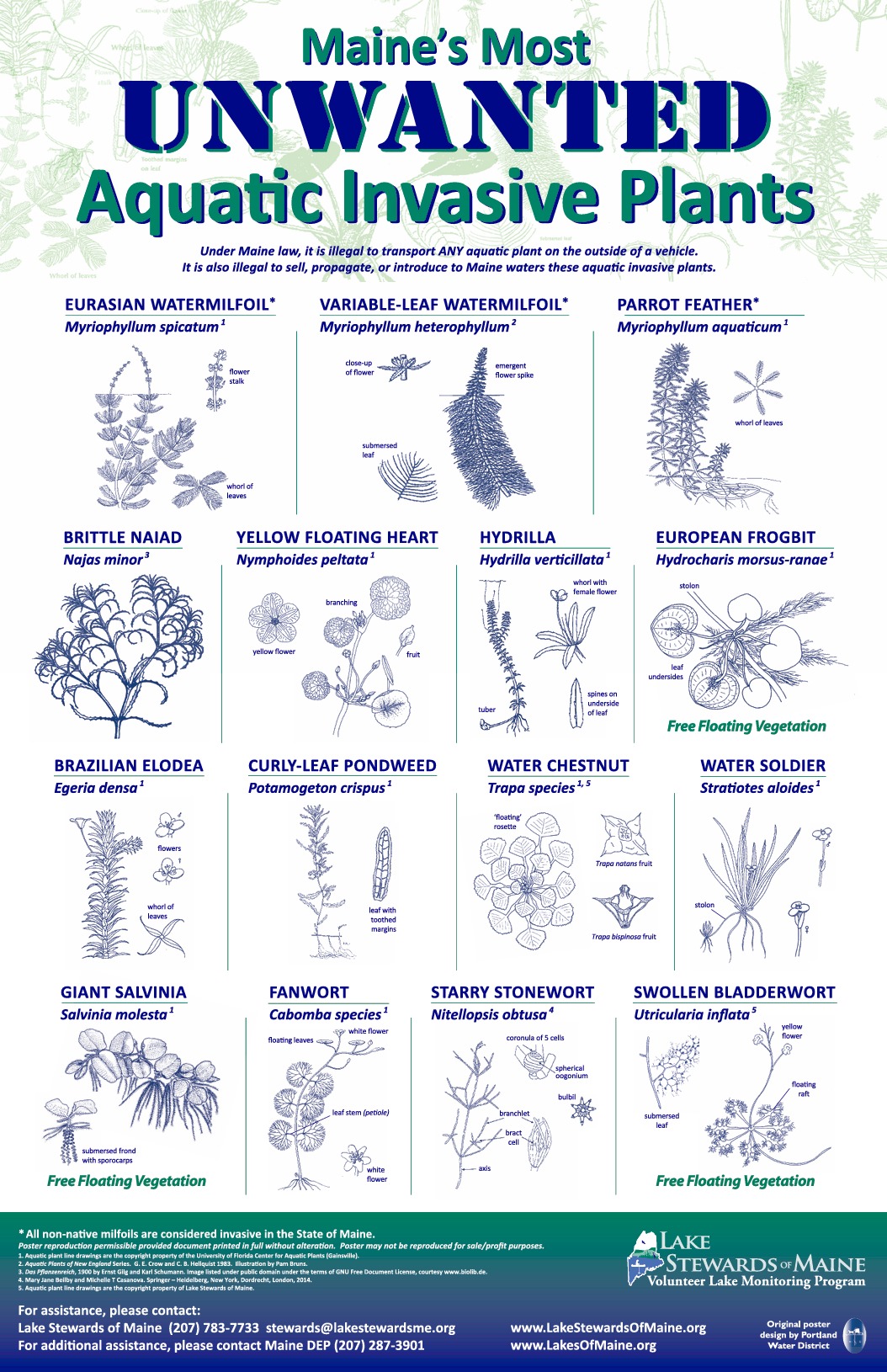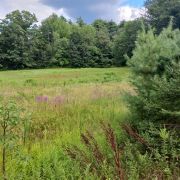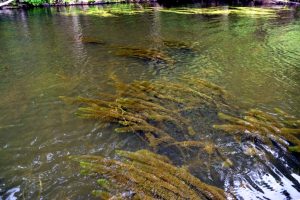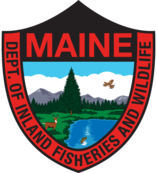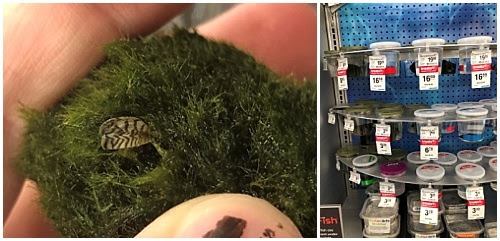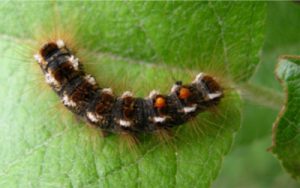Lake Stewards of Maine has released the latest “Maine’s Most Unwanted Aquatic Invasive Plants” poster. The previous version pictured 11 plants. This new one has pictured 15 plants. You can right click the image to view and download a full sized image, or click the image to view and download the file as a PDF. You’ll also find it in our Maps Charts & Graphs gallery.
Category Archives: Invasive Plants & Insects

Purple Loosestrife Eradication Project Update
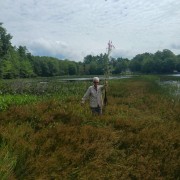 There are a lot of things we don’t want growing in and around Clary Lake, and Purple Loosestrife is on that list. So far we’ve managed to keep on top of it but a small patch in a blueberry field adjacent to Clary Lake managed to get established and is going to take some effort to get rid of. Early last week Malcolm burson (pictured at left) attempted to dig them up by the roots but that proved way to difficult. Alan Clark stepped in and cut the plants down and bagged them up and tossed them onto my burn pile. This will at least keep them from going to seed and making the infestation worse. Next year we’ll round up a team of young vigorous helpers, arm them with shovels and spading forks, and dig them out of the ground properly.
There are a lot of things we don’t want growing in and around Clary Lake, and Purple Loosestrife is on that list. So far we’ve managed to keep on top of it but a small patch in a blueberry field adjacent to Clary Lake managed to get established and is going to take some effort to get rid of. Early last week Malcolm burson (pictured at left) attempted to dig them up by the roots but that proved way to difficult. Alan Clark stepped in and cut the plants down and bagged them up and tossed them onto my burn pile. This will at least keep them from going to seed and making the infestation worse. Next year we’ll round up a team of young vigorous helpers, arm them with shovels and spading forks, and dig them out of the ground properly.
Here are a few more pictures:
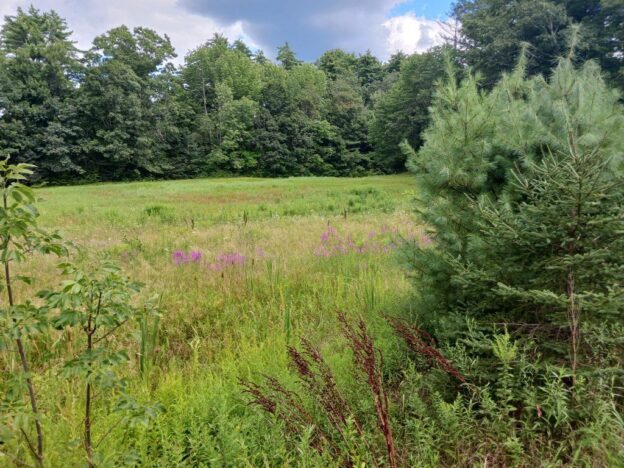
Purple Loosestrife Eradication Project Update
Have you seen this plant growing around Clary Lake? Purple Loosestrife (Lythrum salicaria) is a common invasive plant in Maine. The plant propagates by seed and invades many types of wetlands where it crowds out native plants and degrades wetland habitat. We certainly don’t want it getting a foothold around Clary Lake! For the past 5-6 years we’ve been removing purple loosestrife plants but in many cases, enough root remains for the plants to regrow so it’s an ongoing battle to stop this plant from going crazy. It’s blooming NOW. If you see this plant growing in or around Clary Lake, send and email with picture and description of the location to ipp@clarylake.org. You’ll find a map showing where we’ve found the plant growing on our Purple Loosestrife Eradication Project page.
Browntail Moth Update #7- June 10, 2022
 The Maine Department of Agriculture Conservation & Forestry has issued a Status Update on the Browntail Moth infestation currently impacting the State, and it’s GOOD NEWS! Numbers are way down at their monitoring sites: “This week we are pleased to report we observed at least some fungus-caused mortality at all of our monitoring sites. At a few sites, it wasn’t easy to find live caterpillars to take measurements from, although we did find some after looking on trees a short walk down the road.” While this is generally good news, I know some of you on or around Clary Lake are still in Browntail Moth Hell, and I sympathize. Be patient, this pest is on the way out.
The Maine Department of Agriculture Conservation & Forestry has issued a Status Update on the Browntail Moth infestation currently impacting the State, and it’s GOOD NEWS! Numbers are way down at their monitoring sites: “This week we are pleased to report we observed at least some fungus-caused mortality at all of our monitoring sites. At a few sites, it wasn’t easy to find live caterpillars to take measurements from, although we did find some after looking on trees a short walk down the road.” While this is generally good news, I know some of you on or around Clary Lake are still in Browntail Moth Hell, and I sympathize. Be patient, this pest is on the way out.
Here’s the bulletin, there’s other interesting information in it besides Browntail Moth news:
Summer 2022 Browntail Moth Forecast
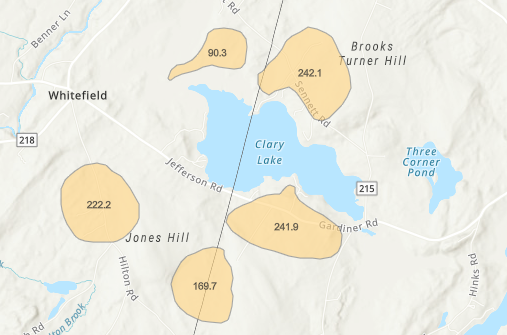 The State of Maine has released a new map using the ArcGis mapping platform to show the state of the Browntail Moth infestation in Maine this year. Last year’s outbreak of the pest was the worst every seen in Maine, and it looks like this year will be very bad again. However, it looks to me like some of the areas that were hardest hit last year (including my property!) may experience less of a problem this year. My property on Clary Lake is surrounded by large red oak trees, and last year ALL of them were completely defoliated for the second year in a row. I feared a third year as bad as the previous two would doom many of my trees. I’m happy to report however that this year I’ve only spotted 1 caterpillar on my screen door and no evidence at all of caterpillars eating the emerging oak leaves. My fingers are crossed, it looks like we won’t suffer a repeat of the last two years this summer. Continue reading
The State of Maine has released a new map using the ArcGis mapping platform to show the state of the Browntail Moth infestation in Maine this year. Last year’s outbreak of the pest was the worst every seen in Maine, and it looks like this year will be very bad again. However, it looks to me like some of the areas that were hardest hit last year (including my property!) may experience less of a problem this year. My property on Clary Lake is surrounded by large red oak trees, and last year ALL of them were completely defoliated for the second year in a row. I feared a third year as bad as the previous two would doom many of my trees. I’m happy to report however that this year I’ve only spotted 1 caterpillar on my screen door and no evidence at all of caterpillars eating the emerging oak leaves. My fingers are crossed, it looks like we won’t suffer a repeat of the last two years this summer. Continue reading
01 April 2022: Unidentified Animal Sighted on Clary Lake
 I spotted this Clary Lake critter this morning when I was out checking my rain gauge. At first I thought it was a goose but the sound it made wasn’t goose-like at all. Sounded more like… I dunno. It was weird. It didn’t stick around. Fortunately I was able to find a picture of it in the webcam archive. Anyone have any idea what this is?
I spotted this Clary Lake critter this morning when I was out checking my rain gauge. At first I thought it was a goose but the sound it made wasn’t goose-like at all. Sounded more like… I dunno. It was weird. It didn’t stick around. Fortunately I was able to find a picture of it in the webcam archive. Anyone have any idea what this is?
Public Hearing on LD 1826: Interagency Task Force on Invasive Aquatic Plants and Nuisance Species
Sorry for the short notice! This public hearing is TOMORROW! I received this notice of pending legislation in my mailbox just now and decided to post it on our site. The Clary Lake Association is deeply concerned with protecting all Maine lakes and Clary Lake in particular from the unwanted introduction of invasive species. To that end we are 3 years into a long term Courtesy Boat Inspection program and are developing plans for an Invasive Plant Program for Clary Lake. Submitting a short comment to the Environment and Natural Resources Committee is simple and worthwhile. You can see what comments have already been left at the above link. Comments need not be long or involved. This is important. Thank you for being concerned.
The second session of the 130th legislature is underway! While there is a lot going on during the session, there are only a few lake bills we’ll be reaching out to you about this year. The first one has a public hearing coming up soon: Monday, January 10th at 10:30 a.m. via Zoom.
LD 1826 creates a subcommittee of the existing Interagency Task Force on Invasive Aquatic Plants and Nuisance Species. The subcommittee will: Continue reading
17 August 2021: Milfoil Returns to Cobbossee Lake
Eurasian Water-Milfoil was discovered in Cobbossee Lake in 2018 (see our post dated August 8, 2018: “Invasive Milfoil Confirmed in Cobbosseecontee Lake“). The following year Maine’s Department of Environmental Protection treated several areas of the lake with an herbicide in an attempt to kill off the invasive plant. They were optimistic that the treatment would be successful because the infestation was limited (so they thought) to roughly an acre between the north shore and Island Park. Sadly, the following year Milfoil was again discovered in several areas adjacent to the original infestation, which is where this Central Maine Papers newspaper article picks up. Please read it! It paints an ugly but accurate picture of the situation they’re facing trying to eradicate this unwanted aquatic plant: Continue reading
Call To Action: Help Fight Invasive Purple Loosestrife!
For the past 3-4 years I’ve been removing isolated instances of the non-native invasive plant Purple Loosestrife (Lythrum salicaria) that I have found growing in and around Clary Lake. With the help of a couple of other people we’ve been able to keep this invasive plant at bay, but the situation is getting worse and I’m no longer able to keep on top of this issue without enlisting more help. Clary’s lakeshore residents need to step up to help manage this threat. It really is important that we prevent Purple Loosestrife from gaining a solid foothold around Clary Lake.
This year I’ve seen more Purple Loosestrife growing than ever before. A few weeks ago, Kelsie French and I spent half an hour pulling up plants growing down on the east end of the lake and the other day, some of them growing on the edge of the water, and some in as much as 3 feet of water. I spotted another large plant growing on the edge of the marsh over by Duncan Road the other day but was unable to get to it in my boat. You can see a good sized field of it doing what it does best, spreading uncontrolled in a small field across the road from the Whitefield Post Office. I’ve written about this invasive plant several times in recent years (see “29 July 2018: Have You Seen This Plant? [UPDATED]“). We need to take seriously the threat this invasive plant poses for Clary Lake. Continue reading
15 June 2021: Trapping Browntail Moths
While killing Browntail moth caterpillars is easy and may make you feel better, it’s problematic for a variety of reasons. First, it gives you the sense that you’re doing something to rid yourself of the Browntail problem when in reality you’re probably not making a dent at all in the caterpillar population. If you just spray them with soapy water, sure it kills them, but then you’ve got dead caterpillars with their toxic hairs laying around your yard. I did that last month, fanatically wandering around my deck and yard with a spray bottle of soapy water in each hand, shooting caterpillars like some madcap wild west gunslinger. Of course, I got the rash on my arms and neck. Then I put aside the spray bottles and took up a tin can with some soapy water in it and kitchen tongs and went around picking the caterpillars up and dropping them in the can. More rash. Now that the caterpillars have begun pupating, I’ve been searching for the nests, cutting down those that I can reach with my tree pruner, and soaking them in a bucket of soapy water. Is this helping? I sure hope so, but I have my doubts. Continue reading
Browntail Moth Hell [UPDATED]
If you’ve managed to avoid getting a Browntail Moth rash so far this summer, congratulations- and be careful, the summer isn’t over yet. Many of us haven’t been so lucky, myself and my wife (and most of my neighbors) included. My house is surrounded by large Red Oak trees that hang over my yard and deck. Last year we were still somewhat oblivious to the caterpillars and the risk they pose with the result that we got extensive rashes over large portions of our backs, necks, and arms. This year we’ve been more cautious and have avoided hanging out on our deck and in our yard, with the result that the rashes we’ve developed haven’t been as bad or extensive as they were last year, but they have still been very unpleasant. Both my wife and I have had a few sleepless nights so far this year. Even now as I type this, my hands are itching. Continue reading
22 April 2021: Browntail Moth Update
 The Maine Department of Agriculture, Conservation & Forestry (DACF) and other groups are predicting the 2021 Browntail Moth season will be a bad one. A recent article in the Bangor Daily News (worth reading!) is claiming this will be the worst infestation of BTM in over a century. It sounds like hyperbole but could well be true. The picture at left is a small section of a Browntail Moth 2021 Winter Web Moth Survey (PDF) published by the DACF shows the results of a drive-by survey conducted earlier this winter, hence the survey data are along major roads. The blow up includes Whitefield & Jefferson and shows medium to heavy concentrations of Browntail moth webs along Routes 126, 218, and 215 (South Clary Road). Of particular concern is not just the number of webs spotted (dot colors primarily yellow, tan, and red), but the density of dots which is an indication of how many individual vehicle stops were made. I’ve inserted the above picture into Google Earth. Download this KMZ file and load it into Google Earth. Continue reading
The Maine Department of Agriculture, Conservation & Forestry (DACF) and other groups are predicting the 2021 Browntail Moth season will be a bad one. A recent article in the Bangor Daily News (worth reading!) is claiming this will be the worst infestation of BTM in over a century. It sounds like hyperbole but could well be true. The picture at left is a small section of a Browntail Moth 2021 Winter Web Moth Survey (PDF) published by the DACF shows the results of a drive-by survey conducted earlier this winter, hence the survey data are along major roads. The blow up includes Whitefield & Jefferson and shows medium to heavy concentrations of Browntail moth webs along Routes 126, 218, and 215 (South Clary Road). Of particular concern is not just the number of webs spotted (dot colors primarily yellow, tan, and red), but the density of dots which is an indication of how many individual vehicle stops were made. I’ve inserted the above picture into Google Earth. Download this KMZ file and load it into Google Earth. Continue reading
09 March 2021: IF&W Issues Invasive Species Alert
I was talking with a friend the other day about different ways that invasive plant and animal species can find their way into Maine lakes. One common way that doesn’t immediately come to mind is summer visitors dumping their aquariums including potentially invasive plant and animal species into a lake or pond at the end of the vacation season. The Maine Department of Inland Fisheries and Wildlife sent this PSA around today:
|
|
5 August 2020: CBI Mid-Summer Update

Jack Holland conducting courtesy boat inspections at the State boat launch. Photo by George Fergusson
Our Courtesy Boat Inspection program is running like a well oiled bicycle this summer, thanks to an energetic and committed volunteer work force. We got a bit of a late start last year, but this year we started boat inspections on Memorial Day weekend and have managed to have volunteers at the State boat launch every weekend from 6 AM until 2 PM ever since. To date we’ve staffed 93 two-hour shifts for a total of 192.1 volunteer hours and have conducted 315 inspections. So far this year we’ve only found one plant on an inbound boat that turned out not to be invasive. State-wide there have been 4,312 shifts (most are two hour shifts but some are longer) and 54,815 inspections conducted and 1,616 plants were found, 67 of which have been identified as invasive plants. I’d say the program is working! You can look at the data directly using the 2020 Maine Courtesy Boat Inspection Dashboard. Select the Clary Lake Association from the “Select Organization” list to see our data. Continue reading
02 August 2020: July Water Level Chart Archived
I have archived the July 2020 Water Level Chart (at left). For the third month in a row we’ve managed to maintain a relatively stable water level despite mild drought conditions prevalent at the start of the month. The lake level fluctuated only 1.5 inches from low to high over the course of the month, starting out at -0.50 feet and ending the month with the lake level at -0.41 feet. A number of people have let us know that they think the lake level this summer has been about perfect. We were shy of the monthly average rainfall until two back-to-back squalls on July 30th dumped a little over an inch of rain and pushed our monthly rainfall total to 3.77 inches, a little over the average for July of 3.54 inches. Because of an extra dry June, we’re still 0.28 inches below average for this date.
Tropical storm Isaias is due to pass through Maine this coming Tuesday night into Wednesday, and it has the potential of dropping several inches of rain, if not more. We’ve temporarily increased outflows so as to create a little head space to accommodate the anticipated storm water runoff. We don’t expect any significant flooding or a major change in the water level when it’s all said and done. Continue reading
6 May 2020: Browntail Moth Season Ahead!
Any day now, over-wintered Browntail Moth caterpillars will start to emerge from their tree-top leaf nests and start eating. Last year they did a great job (?) of defoliating Oak trees around Clary Lake and spreading their poisonous hairs all over the place. The south shore of the lake by Hodsdon Lane was particularly hard hit. I haven’t seen near as many Browntail moth nests in the trees around my house this spring, making me think this year the infestation may be less severe than last year, but it still pays to be alert to the risk they pose to our trees and our health. According to the newly published Browntail Moth Risk Map (PDF | 2.44 MB) however, the towns of Whitefield and Jefferson still have a HIGH Browntail Moth Risk Rating. Continue reading

